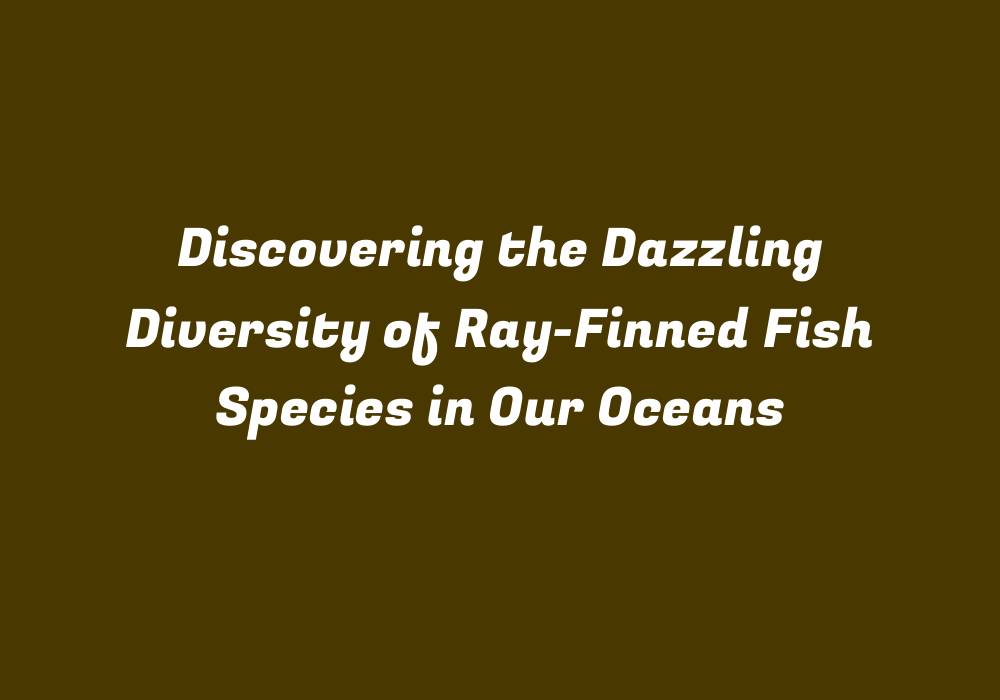Uncovering the Rich Variety of Ray-Finned Fish Species in Our Oceans
Introduction
Our oceans are home to a vast array of aquatic life, which has evolved over millions of years into an impressive diversity of marine creatures. Among these species, ray-finned fish stand out as a fascinating and highly diverse group. This article aims to shed light on the extraordinary biodiversity of ray-finned fishes in our oceans, showcasing their numerous types, unique traits, and vital roles they play in the marine ecosystems.
The Dazzling Diversity of Ray-Finned Fish Species
Ray-finned fish belong to the Actinopterygii class, which makes up approximately 98% of all known fish species. Within this group, there are over 30,000 different types of ray-finned fishes, with new discoveries constantly being made. This immense diversity can be attributed to several factors, including their evolutionary history and various adaptations they have developed over time.
Evolution and Adaptation
Ray-finned fish have been around for a long time, with their origins dating back to the Silurian period about 400 million years ago. Throughout their extensive evolutionary journey, they have adapted to a wide range of environments and lifestyles, which has resulted in an immense diversity of species. These adaptations include changes in size, coloration, body shape, feeding habits, reproductive strategies, and more.
Classification and Types of Ray-Finned Fish Species
Ray-finned fishes are classified into various orders and families based on their physical features, genetic makeup, and behaviors. Some common groups of ray-finned fish include:
1. Perciformes (Percoids) – This is the largest group of ray-finned fish, which includes bass, perch, grouper, sea bass, snook, and many more species. They inhabit diverse habitats ranging from freshwater to marine environments.
2. Clupeomorpha (Herrings and Relatives) – These small fish are characterized by their elongated bodies, silvery coloration, and streamlined shape. Examples of clupeomorphs include herrings, shads, anchovies, and sardines.
3. Cypriniformes (Carp-like Fishes) – Known for their barbels or whisker-like appendages around the mouth, cypriniformes comprise carp, minnows, goldfish, and barbs. These fish are mostly found in freshwater environments.
4. Ostariophysi (Miscellaneous Carps) – A diverse group of ray-finned fishes with unique features such as air bladders and modifications to their swim bladder systems, ostariophysians include catfishes, siluriformes, characoids, and many more.
5. Salmonidae (Salmonids) – These fish are characterized by their distinctive body shape and coloration. They are also known for their anadromous life cycle, which involves migrating between freshwater and saltwater ecosystems during different stages of their lives. Examples include salmon, trout, and char.
Importance of Ray-Finned Fish in Oceanic Ecosystems
Ray-finned fish play a vital role in maintaining the balance and productivity of oceanic ecosystems through several means:
1. Food Web Contribution – As primary or secondary consumers, ray-finned fishes are integral components of food chains in marine ecosystems. They provide sustenance to various species of larger predators, including sharks, seabirds, and whales.
2. Fishing Industry Support – Many commercial fish species belong to the ray-finned group. The fishing industry relies heavily on these species as a primary source of food and income for communities worldwide.
3. Predation Control – As both predators and prey, ray-finned fishes help control populations of other organisms in the marine environment. By keeping populations in check, they contribute to healthy ecosystem dynamics.
Conclusion
Ray-finned fish represent a stunningly diverse group that has evolved over millions of years to adapt to various habitats and ecological niches in our oceans. Their remarkable biodiversity serves as a testament to the endless complexity and beauty of life underwater, while also playing crucial roles in oceanic ecosystems through their contributions as food sources and natural regulators of populations. With continued scientific research and conservation efforts, we can work towards preserving this magnificent array of ray-finned fish species for future generations to appreciate and understand.
